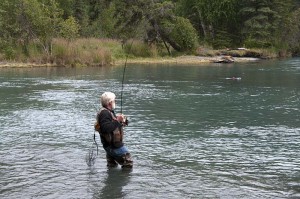It drizzled rain all night, and was still raining slightly when we awoke. We ate our breakfast under the back door of the Yukon, and put the tent away as quickly as possible. The fly was very wet, but the rest was not too bad. It was a very good thing that we changed to a new groundsheet, as there were almost no damp spots in the tent this morning.
We drove back following the Skilak Lake road. This lake is a large lake on the Kenai River, and also is fed from Skilak Glacier, another of the many glaciers that descend from the Harding Icefield. We stopped at a number of the other small lakes along the road. They are very pretty, but the sky was very overcast, though by this time it had stopped raining. We ate lunch at Hidden Lake. This is the most developed of all the campsites we have been at in Alaska. The road in the campground is paved (though Skilak Lake road is not), and there were two picnic shelters, one of which we made use of.
After lunch we stopped at the Kenai Lake trail, and walked in about 2 kilometres in total to the top of the canyon. About 500 metres in we reached the bank of the Kenai River, where there were several fishermen catching sockeye salmon. They were actually snagging them with their hooks there were so many in the river. They released them all (you aren’t allowed to take them by snagging) though they put up a pretty good fight. The one fisherman we talked to said they were past their prime. He said they would be ok if you smoked them, but, “they’re spawned out,” so they were releasing them all.
We watched them fish for a while then continued on down the trail. There were a large number of mushrooms of different varieties. We also saw some fresh bear scat along the trail, full of berries. The Alaskan Brown Bear is genetically the same as the grizzly, but much larger because of all the salmon that it has available. The young man we shared the fire with last night said that there are many bear encounters right within the city of Anchorage each year, mostly with bikers and runners who come on the bears suddenly. He also said that the Alaskan Brown Bear is much less aggressive than the grizzly (though more so than a black bear) probably because it has a much easier time getting sufficient food.
We stopped hiking when we came to the high cliff about 30 metres above the water of the Kenai River. The canyon is quite narrow at this point, perhaps 25 to 30 metres wide, and had some white water. Of course if you were on the water rather than looking down the rapids doubtless would be much larger. We saw a raft floating through the canyon, and it looked as if it was a fairly easy ride.
Shortly after we started driving again the rain started anew. It wasn’t too heavy, though as we got close to the Hope junction, it was raining heavily enough that we were thinking about getting a motel room, since our tent was put away so wet this morning. However the rain had stopped by the time we arrived at Bird Creek campground. In fact the sun broke through around supper time, so the tent is nicely dry, and its warmer this evening than it has been for some days.
After supper we walked down to where Bird Creek enters the ocean. There were many people fishing there, and though we saw no one catch a fish, we did see one person carrying a large silver salmon. The creek is stocked, and according to the sign there are about 7500 salmon caught there every year by anglers. We spoke to a man on the footbridge overlooking the creek, and he said you can often see Beluga coming up the creek following the salmon. However we saw none tonight.

